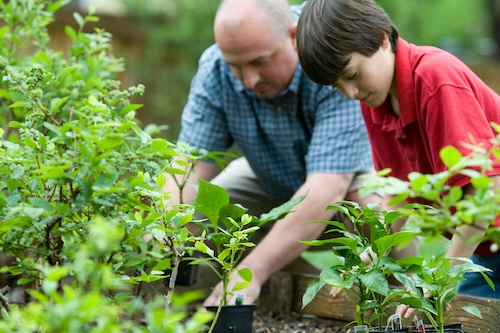Ongoing care, maintenance and TLC of your garden throughout the growing season will ensure success.
Mulching
- Mulching is an option around your plants to conserve moisture, cool soil temperatures, and deter weeds. Use straw, grass clippings, or shredded leaves for easy organic mulch. You can find additional information on mulching a vegetable garden at https://getbusygardening.com/mulching-vegetable-garden/
Watering
Now that plants are established, water at least daily and be attentive to extreme heat and sunlight, as well as your plants’ needs for additional water.
- Since this has been a very hot summer you may want to water twice a day, especially as your plants get bigger and the temperatures continue to rise.
- The best time of day to water is in the morning.
- Water regularly and conscientiously. Less frequent, deep watering is better than shallow watering as it promotes deep root growth. Plants with deep roots are stronger and won’t need to be watered as often.
- Frequent, light watering will cause shallow roots, which will require you to water them more often.
- Do not water the foliage – water the soil around the “drip line”, which is the outer edge of the plant, or the point where water would drip from the outer leaves.
- Tip: Inconsistent watering is a contributing factor to blossom end rot (a water soaked spot on your vegetables), as well as cracked vegetables.
Weeding
- Be diligent in weeding your garden. Weeds compete for water, sunlight, and nutrients, so regular weeding is necessary. Children often enjoy weeding the garden and this activity can be a family project, with everyone contributing and observing the results.
- Weed often and refer to these 12 natural ways to control weeds.
General Maintenance, Feeding and Fertilizing
- Most summer vegetables need at least one feeding. Use a slow-release, granular organic fertilizer and apply according to the package directions.
- Pinch or prune tomatoes, peppers, cukes, gourds, squash and others. For how to do this, see the article How to Pinch Plants: Pruning Tomatoes, Peppers, Cucumbers, and More | Almanac.com
- Vining crops like indeterminate tomatoes, melons, and cucumbers need support. Tie them to sturdy trellises, stakes, or other support structures. Peppers are not vines, but they too may need support.
- Here is additional information on fertilizing vegetable gardens.
Supplementing Your Garden
If you would like to add to your garden, there is still time to:
- Plant beans, summer squash, peppers, lettuce, and cucumbers. As you harvest your crops, you can backfill the space with other vegetables for variety.
- Thin beets and carrots. If you have room, plant more to mature in the fall.
- Plant herbs in windowsill trays or patio containers – pinch the tops off regularly to promote new growth and prevent them from becoming leggy.
- You may also consider planting some other crops (potatoes, tomatoes), but research the variety and how long they will take to harvest, to determine if the growing season in New England will accommodate them.
What to Do In July
-
- Evaluate your garden daily, including placement of crops, growth and progress, and pest control. Modify as necessary and continually water and maintain your garden.
- Some crops need help during extremely hot weather, including shade netting to protect the plants. Please refer to this article on how to Help Your Garden Endure Hot Weather.
- Follow all the maintenance tips above, but in general, keep abreast of the three W’s:
- Water
- Weed
- Watch for pests and critters, and refer to our June newsletter on Pesky Problems 2.0
- If you are in Japanese Beetle territory, handpick each morning and again late day. Knock them off foliage and drown in a container of soapy water.
Here are some harvesting tips to get you started and refer to the Harvesting Your Garden Tip Sheet for more information:
- Harvest your crops on a timely basis. During warm summers, with high humidity and lots of sunshine, you may experience that crops are ready a bit earlier than usual – for example, tomatoes in July rather than August.
- The best time of day to harvest most vegetables is in the early morning after the dew dries. This is when they are at their sweetest and juiciest. Avoid picking vegetables in the heat of the day, especially leafy vegetables, which can wilt immediately. Handle plants with care.
- If you have planted basil, marjoram, mint or tarragon it’s best to harvest these before they bloom to flower. The herbs will turn bitter if allowed to flower.
For more tips, information and resources, please visit us at www.framinghamhgardenclub.org/resources-information/







